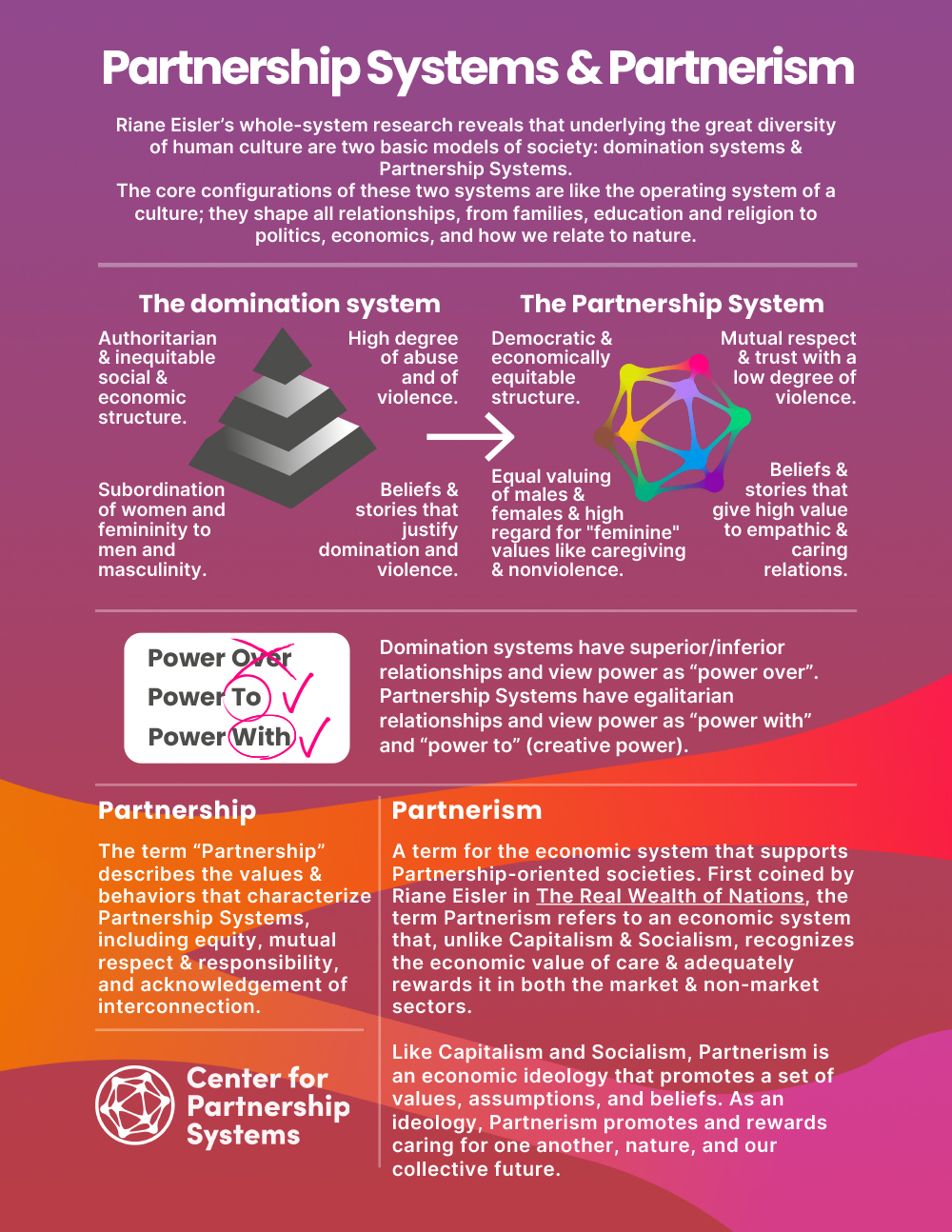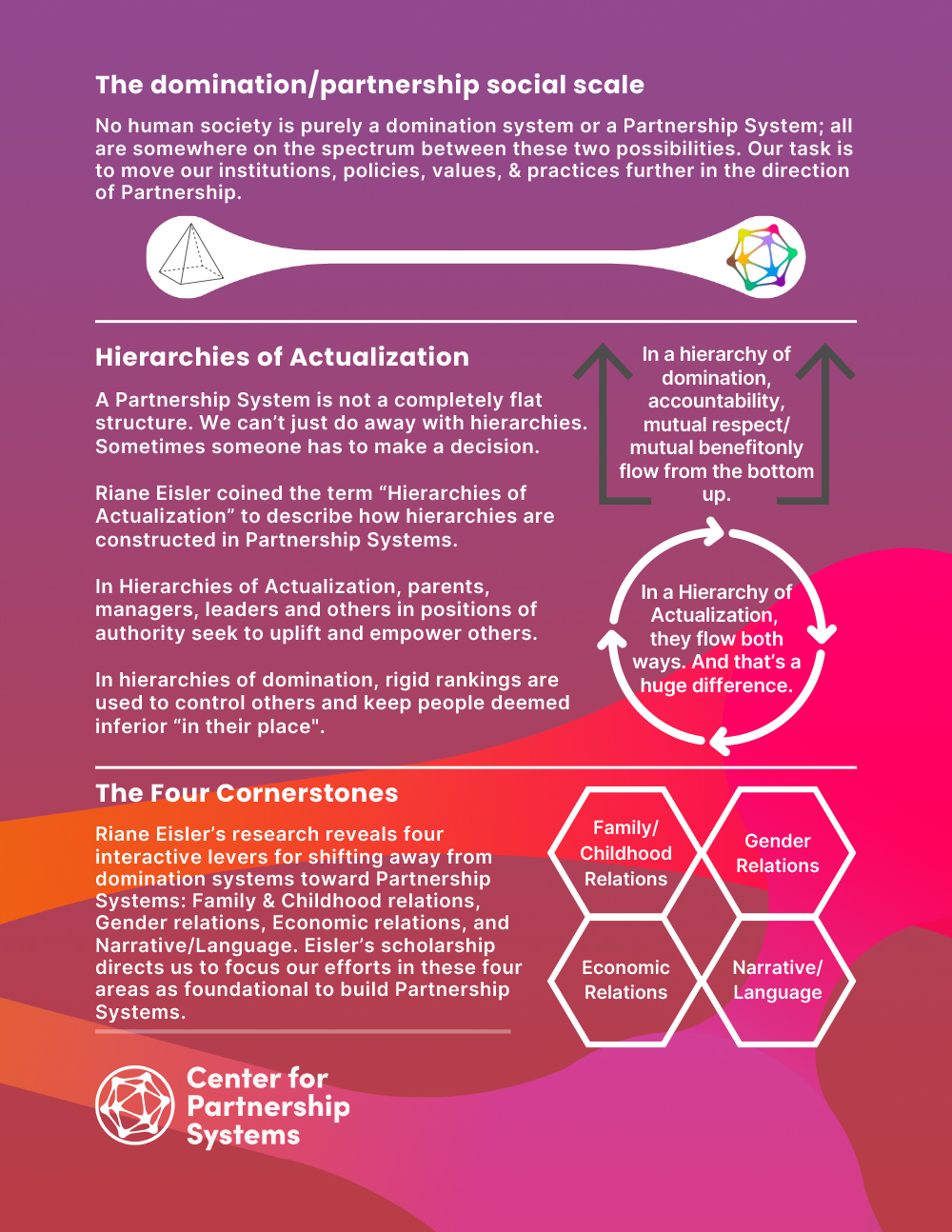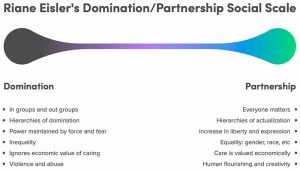Partnerism
Partnerism is an economic and social system based on caring and nature, with an emphasis on a social system based on equality of women and men. It is a direct alternative to domination culture, an economic and social system ruled or dominated by men. Unlike Capitalism and Socialism, Partnerism recognizes the economic value of care and adequately rewards it in both the market and non-market sectors. Partnerism was first coined by Riane Eisler in The Real Wealth of Nations and most internationally recognized in The Chalice and the Blade.
Domination/Partnership Social Scale[edit]
| Domination/Partnership Social Scale | |
|---|---|
| Domination | Partnership |
| In groups and out groups | Everyone matters |
| Hierarchies of domination | Hierarchies of actualization |
| Power maintained by force and fear | Increase in liberty and expression |
| Inequality | Equality: gender, race, etc |
| Ignores economic value of caring | Care is valued economically |
| Violence and abuse | Human flourishing and creativity |
Hierarchies of Actualization[edit]
A Partnership System is not a completely flat structure. We can’t just do away with hierarchies. Sometimes someone has to make a decision. Riane Eisler coined the term “Hierarchies of Actualization” to describe how hierarchies are constructed in Partnership Systems. In Hierarchies of Actualization, parents, managers, leaders and others in positions of authority seek to uplift and empower others. In hierarchies of domination, rigid rankings are used to control others and keep people deemed inferior “in their place".
The Four Cornerstones[edit]
Riane Eisler’s research reveals four interactive levers for shifting away from domination systems toward Partnership Systems. Eisler’s scholarship directs us to focus our efforts in these four areas as foundational to build Partnership Systems. In a hierarchy of domination, accountability, mutual respect/ mutual benefitonly flow from the bottom up. In a Hierarchy of Actualization, they flow both ways. And that’s a huge difference.
Family & Childhood relations[edit]
Partnerism values the work of caring.
Neuroscience shows that what children experience and observe, starting at birth, determines how our brains develop and therefore how we think, feel, and act. Infants and children absorb partnership or domination worldview's from parents' relationships with each other and from their relationships with parents and siblings, long before they go to school and long before critical mental faculties are developed.
Gender relations[edit]
Partnerism values all people, regardless of gender or other differences.
How a society constructs gender roles and relations not only affects everyone’s individual life options; it affects families, education, religion, politics, and economics. When people learn to equate the physical differences between male and female with superiority or inferiority, dominating or being dominated, being served or serving, they internalize a template that can automatically be applied elsewhere: race, religion, ethnic, sexual orientation, etc..
Economic relations[edit]
Partnerism recognizes that the real wealth of our world consists of the contributions of people and of nature.
The gap between haves and have-nots has been growing among and within nations. This is a crisis. Moving to a more robust, sustainable and humane economics is not only vital for human and environmental reasons, but for purely economic ones. A caring economics of Partnerism recognizes that the real wealth of our world consists of the contributions of people and of nature.
Narrative/Language[edit]
Partnerism supports empathetic, mutually beneficial, caring relationships.
We need the language of partnership systems to transcend old categories and to describe beneficial social and economic systems. A caring democracy requires accurate narratives about 'human nature'. This will require a concerted effort in which the arts, music, literature, and education are informed and inspired by science and caring values.
| Domination vs Partnerism Languaging | |
|---|---|
| Domination | Partnership |
| We are shooting for a Thursday deadline | Our intention is to complete this project by Thursday |
| We are aiming to finish | Our plan is to finish |
| Let's target this demographic | Let's focus on this demographic |
| I dodged a bullet | Things worked out for the best |
| Deadline | Deliverables, due date, tasks done, life cycle |
| Fight injustice | Heal injustice |
| Killing time | Filling time |
| Mankind | Humankind |
| Kill two birds with one stone | Feed two birds with one scone |
| I really killed it/crushed it/nailed it | I really brought it to life |
| I will what that into shape | I will concentrate on this project |
| Take a stab at | Attempt, try |
| Things went South | Things went downhill from there |
| Spearhead an effort | Initiate an effort |
| Man the office | Staff the office |
| Command central | Action hub |
| Dumbing down | Simplifying, humanizing |
New Economic Map[edit]
The Partnerism economic model includes the full spectrum of economic relations, from how humans relate to our natural habitat. This requires a complete and accurate map that includes all economic sectors with the household as the core inner sector. In the dominator economy, the foundational economic sectors, household, unpaid community, and natural are N/A (not applicable), omitted.
| New Economic Map | ||||
|---|---|---|---|---|
| Domination | Partnership | Examples | ||
| Household economy | N/A | Core sector | Caring, caregiving | |
| Unpaid community economy | N/A | Second sector | Volunteering, barter, community currency | |
| Market economy | Core sector | Third sector | The conventional fiat economy | |
| Illegal economy | Second sector | Fourth sector | Drug/sex/arms trade | |
| Government economy | Third sector | Fifth sector | Policies/laws/rules governing market economy; public services | |
| Natural economy | N/A | Sixth sector | Natural environment | |
Restructuring Economic Systems[edit]
| Restructuring Economic Systems | |
|---|---|
| Domination | Partnership |
| Ignore contributions of the life-sustaining activities of households, communities, and nature. | Recognize contributions of the life-sustaining activities of households, communities, and nature. |
| Rules, policies, and practices inhibit human development, creativity, equitable relations, mutual responsibility, and concern for nature and future generations. | Rules, policies, and practices support human development, creativity, equitable relations, mutual responsibility, and concern for nature and future generations. |
| Technological applications are driven by an ethos of control and domination. | Technological applications are driven by an ethos of caring and partnership. |
| Measurements of economic productivity include activities that harm people and nature, and fail to include essential non-market life-supporting activities. | Measurements of economic productivity exclude activities that harm people and nature, and include essential non-market life-supporting activities. |
| Economic structures are designed to support concentration of assets and power at the top, with little accountability to those on bottom. | Economic structures are participatory and equitable, designed to support mutual accountability and benefit. |
| Human needs and capacities are often exploited, and nature is depleted and polluted. | Human needs and capacities are nurtured, and our natural habitat is conserved. |
| Investment in developing the high-quality human capital needed for the postindustrial age is inadequate. | Investment in developing the high-quality human capital needed for the postindustrial age is a top priority. |
| Is not sustainable at our level of technology in an inextricably interconnected world. | Can help us meet the social, economic, and ecological challenges we face. |
Social Wealth Economic Indicators[edit]
SWEIs inform us that environmental work and care work, which is the work of caring for others, such as children or the sick and disabled or the elderly, yields significant economic value. Learn more here.
Human Capacity Indicators[edit]
Human Capacity Indicators (HCIs) measure the output dimension, i.e., the degree of human capacity development, where human capacity is understood to refer to the capacities that people learn to utilize not only in service of their own advancement but also in collaboration with others for the advancement of the society and economy in which they live. They are divided into seven subcategories:
- Caregiving Measures
- Education Measures
- Health Measures
- Social Connectivity and Cohesion Measures
- Environmental Measures
- Social Equity Measures
- Entrepreneurship and Innovation Measures
Care Investment Indicators[edit]
Care Investment Indicators (CIIs) measure inputs into the creation of human capacity, i.e., the extent of government and business support for care work, in the form of budgetary allocations, family-friendly laws and workplace practices, and so on. They are divided into four subcategories:
- Government Investment in Care Work
- Business Investment in Care Work
- Public and Private Investment in Protecting the Environment
- Comparative Investment Data
History[edit]
In the prehistory of humans, partnership used to be the norm. In both the Paleolithic and Neolithic periods, there are examples of matriarchal societies preceding patriarchies. British archaeologist James Mellaart, for example, reported a Neolithic site with many female images and no signs of destructive warfare for almost 1000 years. For thousands of years, people lived in these peaceful partnership societies, until warlike nomadic tribes disrupted the balance with their dominator cultures (5000 B.C.E., 3000 B.C.E.).
The Paleolithic Age (3 million to 10,000 B.C.E.)[edit]
Cave art, dating back over 30,000 years from the Paleolithic or Old Stone Age, Stone Age, does not express any form of domination culture. Instead of images celebrating the power to take life, what we instead see are images celebrating the life giving and nurturing powers of nature, often as incarnated in the body of woman.
The Neolithic Age (10,000 to 3000 B.C.E.)[edit]
In the Neolithic or first agrarian cultures going back about 10,000 years, we first see a profusion of female images, and, reflecting a massive cultural shift, their disappearance toward its end. We see the first signs of domination culture stemming from nomadic culture around 5000 B.C.E., and becoming widespread by 3000 B.C.E.
The Bronze Age (3000 B.C.E. to 1000 B.C.E.)[edit]
The Minoan civilization on the Mediterranean island of Crete was a high civilization: a technologically, artistically, economically, and socially developed, centralized society, that flourished under a partnership-oriented system, with art, governance, economy and architecture that revered women and nature. It was one of the last remaining large-scale partnership civilizations in the world until domination culture replaced it.
Economy Policy[edit]
The economic policy goal of Parnerism is in developing the human capabilities of each person, not the level of monetary income per person.
Resources[edit]
Education programs in Regenerative Development
Websites
- partnerism.org - Information site dedicated to activating a mainstream movement to build Partnership-based economic and social systems
- centerforpartnership.org - Center for Partnership Systems website
- learnpartnership.org - Learning center for partnerism with a focus on courses
Foundational Books
- The Chalice & The Blade: Our History, Our Future (Riane Eisler, 1988) - The most comprehensive explanation of how and why partnership and domination societies were conceptualized and normalized. Its main message is that our social norms frame our reality, but norms can be evolved towards peaceful and prosperous coexistence.
- Nurturing Our Humanity: How Domination & Partnership Shape Our Brains, Lives, and Future (Riane Eisler, 2019)
- The Real Wealth of Nations: Creating a Caring Economics (Riane Eisler, 2008)
- The Partnership Way: New Tools for Living and Learning, Healing Our Families, and Our World (A Practical Companion for "the Chalice and the Blade") (Riane Eisler, 1990) - Provides group exercises and activities as well as case studies of groups from different sectors learning about and implementing partnerism.
Additional Books
- Sacred Pleasure: Sex, Myth, and the Politics of the Body – New Paths to Power and Love - An intensive read on politics and inequality throughout written history, ex. institutionalized patriarchy.
- Nurturing Our Humanity: How Domination and Partnership Shape Our Brains, Lives, and Future - Research and insight in the neuroscience behind the two social systems of partnership and domination respectively and how they shape our internal and external realities. It addresses the importance of childhood experiences and learning, and our true human instincts of caring and compassion.
Documents
- Partnership Systems & Partnerism One Page - An informative infographic that highlights all the main components and building blocks of partnerism.
- How to Turn 20 Everyday Phrases From Negative to Positive - Shifting towards partnership/positive rhetoric and dismantling underlying violent/domination norms]
Partnerism Media Kit[edit]
Link to Partnerism Media Kit pdf by Center for Partnership Systems


Defining caring[edit]
Caring, caregiving in Partnerism are defined as activities guided by a caring orientation over a longer time horizon. It not only fulfills human needs and aspirations, it also offers a wholly different approach to business and government policies that are both financially and socially profitable. A caring orientation includes giving visibility and value to:
- the work of caring for children, the sick, and the elderly in households
- caring work in the market economy, such as child care, teaching, nursing, and caring for people in retirement homes
- being ethical in business and government
- the civic labor of building healthy communities, the social justice labor of progressive social movements, and the environmental labor needed to preserve a healthy natural environment for ourselves and future generations.
A caring orientation is also distinguished by a longer time horizon, taking into account short-term and long-term considerations.
